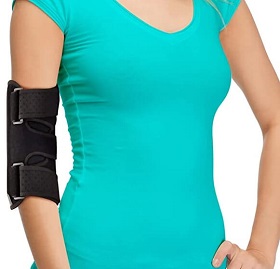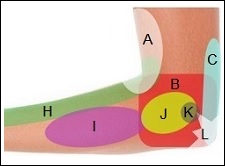- Home
- Elbow Pain Diagnosis
- Cubital Tunnel Syndrome
Cubital Tunnel Syndrome
Written By: Chloe Wilson BSc (Hons) Physiotherapy
Reviewed By: SPE Medical Review Board

Cubital tunnel syndrome occurs when the ulna nerve is pinched or irritated at the elbow.
This causes inner elbow pain that radiates down through the forearm and into the hand, as well as tingling and numbness in the ring and little finger.
Also known as Ulnar Nerve Entrapment or Ulnar Neuritis, cubital tunnel syndrome is one of the most common types of nerve injury in the upper limb, second only to carpal tunnel syndrome.
The symptoms of cubital tunnel syndrome feel very like when you hit you “funny bone” – shooting pain down your forearm and pins and needles in your hand. This is because the “funny bone” isn’t a bone at all, it is actually the ulna nerve!
Here we will look at what cubital tunnel syndrome is, the common causes and symptoms, how it is diagnosed and the different surgical and non-surgical treatment options for ulnar nerve entrapment.
What Is Cubital Tunnel Syndrome?
Cubital tunnel syndrome occurs when the ulnar nerve is injured, irritated or compressed at the elbow.
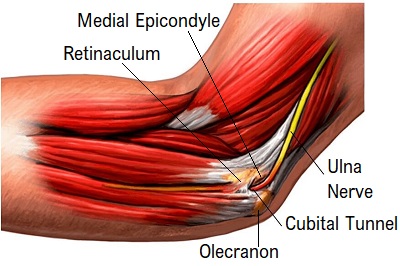
The ulnar nerve travels all the way from the neck, down the upper arm, round the inner side of the elbow and down into the hand.
There are a few places where the ulnar nerve may become trapped, but the most common is at the elbow where it travels through the cubital tunnel.
The cubital tunnel is found on the inner side of the elbow formed by:
- Medial Side: Medial epicondyle of the humerus
- Lateral Side: Olecranon of the ulna
- Top: Cubital tunnel retinaculum – a ligament that runs between the elbow bones
- Base: medial collateral ligament and joint capsule
The cubital tunnel is a small oval-shaped space that is very narrow so it is easy for the ulna nerve to get pinched as it travels through here. This leads to irritation and inflammation of the ulnar nerve, known as cubital tunnel syndrome or ulnar nerve entrapment at the elbow.
What Causes Cubital Tunnel Syndrome?
Cubital Tunnel Syndrome is caused by irritation and/or inflammation of the ulna nerve from:
- Compression: pressure through the ulnar nerve
- Stretching: prolonged or repetitive tension through the ulnar nerve
- Narrowing: of the cubital tunnel
- Medical Conditions: certain conditions can increase the risk of developing nerve problems
- Unknown Factors: In many cases the exact cause of cubital tunnel syndrome is unknown
Let’s find out a little bit more about these causes of ulnar nerve entrapment.
1. Compression
Pressure on the ulnar nerve is the most common cause of cubital tunnel syndrome. This may be from a one-off injury or repetitive pinching of the nerve:
- Sustained Pressure: a common cause of ulnar nerve entrapment from compression is direct pressure on the nerve e.g. from leaning through your elbow for long periods or computer work.
- Repetitive elbow bending: and straightening e.g. from reaching, lifting or pulling actions or bench pressing heavy weights, can also cause compression on the nerve. Bending the elbow changes the shape of the cubital tunnel from oval to elliptical which places increased pressure on the ulna nerve.
- Excess fluid build-up: in the cubital space from swelling/inflammation after an injury will also place increased pressure on the ulnar nerve and can result in pinching.
- A Direct Blow: to the inner side of the elbow can place huge instant pressure on the ulna nerve. This is typically referred to as “hitting your funny bone”, not only causing inner elbow pain but a shooting pain and tingling into your ring and little fingers.
2. Stretching
Increased tension on the ulnar nerve can result in cubital tunnel syndrome, particularly if it happens frequently.
This tends to occur when you hold the elbow in a bent position for long periods e.g. talking on the phone or sleeping with your elbows bent all the way up, which stretches the ulna nerve.
As you bend you elbow, the ulna nerve has to stretch around the medial epicondyle and this places tension through the nerve and irritates it.
3. Narrowing
Common causes of cubital tunnel narrowing include arthritis, as bone spurs encroach and narrow the tunnel, and previous elbow injuries e.g. elbow fracture or dislocation.
4. Anatomy
In some cases, it comes down to anatomy – some people have a naturally narrow cubital. And for some people, when they bend their elbow, the ulna nerve slides out from its position behind the medial epicondyle and “flicks over” the bone , which over time, can irritate the nerve
5. Medical Conditions
Some medical conditions increase the risk of developing ulna nerve entrapment, the most common being diabetes, hypothyroidism and obesity.
Cubital Tunnel Symptoms
Cubital tunnel syndrome symptoms will vary from person to person but may include:
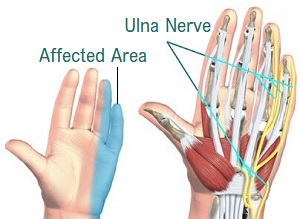
- Tingling And/Or Numbness: Intermittent pins and needles or reduced sensation in the outer hand is common with cubital tunnel syndrome. This is usually felt on both the front and back of the hand into the ring and little finger, particularly when the elbow is bent or at night. Over time, tingling and numbness may become more persistent
- Pain: With cubital tunnel syndrome there is often a background aching pain on the inner side of the elbow. Some people also experience a sharp, shooting pain down the forearm and into the little finger side of the hand when they bend the elbow or place any pressure on the nerve e.g. leaning on their elbow
- Weakness: and clumsiness in the hand is common with ulna nerve entrapment. This can make it harder to manipulate objects and can affect your grip strength and finger dexterity, affecting activities such as typing or playing a musical instrument
- Muscle Wasting: In chronic cases of cubital tunnel syndrome where there has been prolonged ulna nerve compression for a number of weeks/months, some of the hand muscles may start to waste due to lack of activation. Unfortunately this is often irreversible so prompt treatment is really important with ulna nerve entrapment
The ulna nerve supplies the ring and little finger so ulna nerve entrapment will only cause symptoms in that part of the hand. If there is tingling or numbness elsewhere in the hand, then it is more likely to be carpal tunnel syndrome.
Diagnosing Ulna Nerve Entrapment
Cubital tunnel syndrome can usually be diagnosed by your primary care physician (GP). They will start by taking a full history, asking questions about your signs and symptoms, how and when they started, aggravating and easing factors and past medical history.
They will then carry out a physical examination which may involve:
- Assessing Range Of Motion: of your neck, shoulder, elbow wrist and hand. They are looking for any restriction in movement and whether any specific positions make your symptoms better or worse
- Assessing Muscle Strength: in the arm, wrist and hands to identify any weakness
- Assessing Sensation: in the hand to identify any areas of numbness or reduced sensation to touch and in some cases temperature
- Assessing Neural Tension: using neurodynamic tests aka upper limb tension tests to assess the irritability of the nerves
- Special Tests: to look at the integrity and irritability of the ulna nerve. The most common one used is Tinel’s Test which involves tapping over the ulna nerve at the inner elbow. A positive test would cause tingling in the ring and little finger and/or outer hand, but this can sometimes occur when testing a completely normal nerve so it is important to compare arms
You doctor may then send you for various diagnostic tests such as:
- X-rays: of your neck, elbow and/or wrist to look for any signs of arthritis or bone spurs that may be placing pressure on the ulna nerve
- Nerve Conduction Studies: which look at how fast and how strong the electrical activity is in the ulna nerve. An area of the nerve is stimulated and the response time is measured. This is then repeated at different points along the nerve. If the response in a certain area is slower than expected, it indicates that the nerve is getting pinched which inhibits nerve conduction
- Electromyography: EMG testing measures the electrical activity of your muscles by looking at how well they respond to the signals from the ulna nerve, both at rest and when contracting. If the muscles don’t work as expected it may indicate ulnar nerve entrapment
- Ultrasound: diagnostic ultrasound imaging is one of the most reliable cubital tunnel syndrome tests, measuring the cross-sectional area of the nerve. The nerve can be view from multiple angles in a variety of positions so it is an effective way of identifying ulna nerve entrapment
The cubital tunnel syndrome icd 10 code is G56.20
Cubital Tunnel Syndrome may present similar to medial epicondylitis aka Golfers Elbow, which causes pain and tenderness on the inner elbow that may radiate down the forearm to the hand. Golfers elbow may cause weakness in the hand but there won’t be the tell-tale tingling or numbness in the ring or little fingers that there is with ulnar nerve entrapment. There are also other conditions that can cause inner elbow pain.
Cubital Tunnel Syndrome Treatment
Most cases of ulnar nerve entrapment can be treated without the need for surgery although it may take a number of months for cubital tunnel syndrome symptoms to settle completely.
Cubital tunnel syndrome treatment usually involves:
1. Rest
It is really important to avoid any aggravating activities with ulna nerve entrapment otherwise the nerve will become increasingly irritated and symptoms will likely get worse. The main things to avoid are repetitive or sustained elbow flexion and leaning on your elbow, particularly on hard surfaces.
2. Cubital Tunnel Syndrome Brace
Wearing a padded cubital tunnel syndrome brace or splint at night holds your elbow in extension and stops it from bending. This helps reduce the tension through the ulna nerve allowing time for the irritation to settle.
An alternative is to wrap a towel around your elbow each night to prevent it from bending. You may need to wear a cubital tunnel syndrome brace at night for 3-4 months before your symptoms fully settle
3. Elbow Pad
If you can’t avoid leaning on your elbow e.g. because of your job, wear an elbow pad to keep the pressure off the nerve. It really does make a big difference.
4. Medication
Some people find that non-steroidal anti-inflammatories e.g. ibuprofen/naproxen help to reduce cubital tunnel syndrome symptoms. Always check with your doctor or pharmacist before taking any new medications.
5. Steroid Injections
Some doctors recommend cortisone injections as part of cubital tunnel syndrome treatment. Cortisone is injected above and below the site of the ulna nerve compression rather than into the nerve itself to prevent nerve damage.
Ideally, steroid injections should be carried out under ultrasound guidance to effectively target the exact location of compression otherwise there may be little improvement in symptoms.
6. Cubital Tunnel Syndrome Exercises
Your physical therapist may teach you some ulnar nerve gliding exercises to help the nerve to slide through the cubital tunnel more smoothly and reduce tension on the nerve.
Ulna Nerve Glide A

- Bring your arm out to the side, shoulder height, elbow bent, palm facing away from your body
- Keeping your shoulder down, bend your hand alternately forwards and backwards as shown
- Repeat 10-30 times
You can decrease the stretch by tilting your head towards your shoulder (same side as you are stretching) or increase the stretch by tilting your head towards the opposite shoulder
Ulnar Nerve Glide B
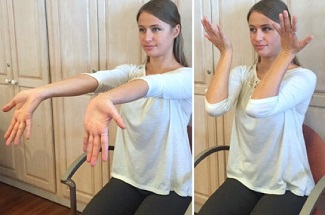
- Sit tall and reach your affected arm straight out to shoulder height, palm facing up
- Bend your wrist back so your fingers point to the floor
- Bend your elbow bringing your wrist towards your face, keeping your wrist bent back, then lower down
- Repeat the movement 10-20 times
You can reduce the stretch by not fully straightening your elbow each time.
Ulna Nerve Glide C

- Sitting or standing, pinch your thumb and index finger together as shown
- Twist your hand round towards you and reach up, placing your palm on your cheek as shown so you can see through the hole created by your thumb and index finger. Then lower down
- Repeat 10-30 times
The movement may feel strange at first but image your hand is a mask! You can reduce the stretch by just gently making contacting with your face rather than bringing your thumb and fingers all the way up.
Cubital Tunnel Surgery
Most cases of ulnar nerve entrapment will settle down with non-surgical treatment but in more persistent or severe cases, surgery may be necessary.
Cubital tunnel surgery is indicated if there is:
- No Improvement: after 3-6 months of non-surgical treatment
- Severe Compression: of the ulna nerve
- Muscle Damage: if the ulna nerve entrapment has caused severe weakness or muscle wasting
There are a few different options with cubital tunnel surgery and your doctor will be able advise which one is best suited to you.
1. Cubital Tunnel Release Surgery
With cubital tunnel release surgery, aka decompression, the ligament that runs over the top of cubital tunnel is cut and divided. This helps to increase the diameter of the tunnel which in turn reduces the pressure on the ulna nerve.
Cubital tunnel release surgery works best in mild to moderate cases of ulnar nerve entrapment but is not the best option if the nerve is prone to slipping in and out of place behind the medial epicondyle.
2. Ulnar Nerve Anterior Transposition
With anterior ulnar nerve transposition surgery, the ulna nerve is moved and repositioned from running behind the medial epicondyle to running in front of it. This helps to ensure the nerve doesn’t get caught behind the bony lump and stretched each time you bend your elbow, and it shortens the course of the nerve around the elbow, reducing the tension on it.
3. Medial Epicondylectomy
The third option with cubital tunnel surgery is a medial epicondylectomy, where part of the medial epicondyle is removed. This allows more space for the nerve to move and is particularly useful if the nerve is getting pinched in more than one place or if you have ongoing symptoms despite previous cubital tunnel surgery.
In some cases, combination surgery may be performed, where a cubital tunnel release is combined with either anterior transposition or medial epicondylectomy.
Cubital Tunnel Surgery Recovery
Most cases of cubital tunnel surgery are performed as day cases so you can usually go home the same day. They may be performed under general or local anaesthetic with an incision made on the inner aspect of the elbow. Surgery usually takes 30-60 minutes, depending on which method is being used.
Following your cubital tunnel surgery, you will be given a sling to wear for the first few days. You may also be advised to wear a splint for a few weeks to keep the elbow in a bent position and allow the area time to heal. You will usually need to wear the splint for 2-6 weeks, depending on the type of cubital tunnel surgery you underwent. You will also need to restrict certain activities such as heavy lifting and sports for around 1 month.
Applying ice and keeping the elbow elevated for the first few days can help to reduce pain, stiffness and swelling.
You will be given a rehab program to work through by your physical therapist consisting of graded range of motion and strengthening exercises for your shoulder, elbow, wrist and hand to help restore full mobility and strength in the arm.
Full recovery from cubital tunnel surgery usually takes between 3-6 months but some people do notice improvements for up to 18 months post-surgery.
Which Is Right For You?
There are pros and cons of each type of cubital tunnel surgery but your surgeon should be able to recommend which is best for you.
Cubital Tunnel Release is the least invasive and quickest to perform, but doesn’t shorten the course of the nerve. It may also result in the formation of scar tissue and tethering which can actually reduce the neural glide and increase the tension on the nerve.
Anterior ulnar nerve transposition and medial epicondylectomy work better than cubital tunnel release if the ulnar nerve is getting trapped behind the medial epicondyle or “flicking” over it when the elbow bends. Ulnar Nerve Transposition is less invasive as there is no trauma to the bone but is 5x more likely to require further surgery due to ongoing symptoms.
Medial epicondylectomy creates the most space but is also the most invasive.
A systematic review published in the Journal of the American Medical Association (JAMA) comparing the different types of cubital tunnel surgery concluded that cubital tunnel release had the lowest risk of complications and the addition of an epicondylectomy increased the probability of symptomatic cure without increasing the risk of complications.
Summary
- Cubital Tunnel Syndrome, aka Ulnar Nerve Entrapment, is caused by pinching of the ulna nerve at the elbow
- Cubital tunnel syndrome symptoms usually consist of inner elbow pain and tingling/numbness in the ring and little finger. You may also get a shooting pain down your forearm into the hand (little finger side)
- Ulnar nerve entrapment is usually caused by pressure on the nerve or increased tension through the nerve.
- Common causes of cubital tunnel syndrome include repetitive or sustained elbow flexion, leaning on your elbow for long periods, inflammation, elbow injuries and certain medical conditions
- Non-surgical treatment usually involves rest, medication, wearing a cubital tunnel syndrome brace and exercises.
- Severe or persistent cases may require cubital tunnel surgery
- Another common cause of inner elbow pain is medial epicondylitis aka golfer’s elbow
Related Articles
Medical & Scientific References
- SA Journal Of Radiology: Ultrasound diagnosis of ulnar nerve entrapment by confirming baseline cross-sectional area measurement for normal and abnormal nerves. By Roodt, T, Van Dyk, B, Jacobs, S. August 2015
- JAMA Network Open: Safety and Outcomes of Different Surgical Techniques for Cubital Tunnel Decompression: A Systematic Review and Network Meta-analysis. By Wade RG, Griffiths TT, Flather R, Burr NE, Teo M, Bourke G. November 2020
Page Last Updated: February 4th, 2025
Next Review Due: February 4th, 2027
